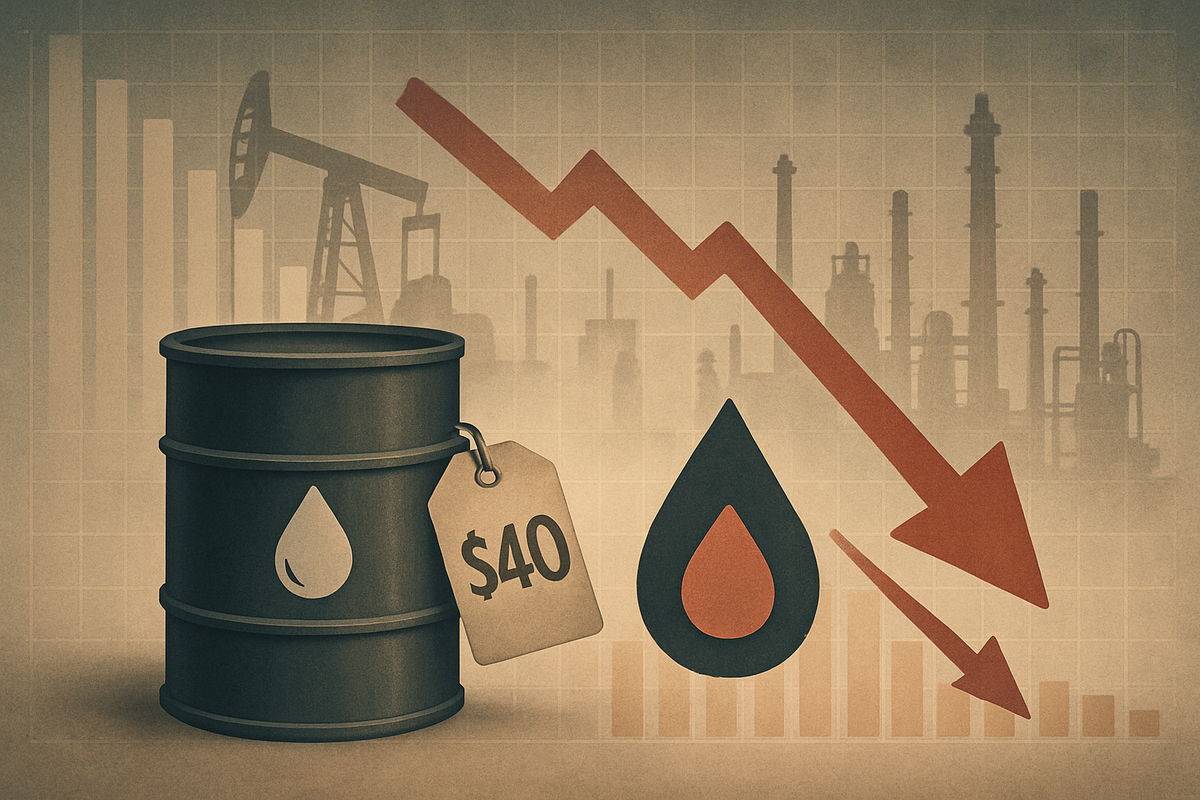
The U.S. upstream oil and gas sector witnessed a significant and concerning downturn in mergers and acquisitions (M&A) activity during the third quarter of 2025. Deal values plummeted to a mere $9.7 billion, marking the third consecutive quarterly decline and extending a trend that saw a 60% drop in dealmaking in the first half of the year compared to 2024. This precipitous fall is largely attributed to persistently low crude oil prices, which have created a challenging environment for both buyers and sellers, casting a shadow over the health of the broader oil and gas market.
The immediate implications of this slowdown are profound, signaling a strategic shift within the industry. Companies are increasingly prioritizing capital discipline and shareholder returns over aggressive expansion, while the scarcity of premium assets and rising cost of capital further dampen M&A appetite. This environment, however, also presents unique opportunities for well-capitalized players to acquire assets at potentially more favorable valuations, particularly in the natural gas sector and among small to mid-cap companies.
The Chilling Effect of Low Prices on Dealmaking
The significant contraction in U.S. upstream M&A in Q3 2025 is a direct consequence of several converging factors, with persistently low crude prices at the forefront. Throughout the quarter, crude prices often hovered in the mid-$60s per barrel or even lower, making it difficult for sellers, especially private equity firms holding oil-weighted assets, to justify divestitures. Many potential shale M&A opportunities simply couldn't deliver the desired returns at these price points, with only a limited number of shale locations proving economic at $50/bbl WTI.
Adding to the complexity was the intense price volatility observed in the preceding months. Brent crude, for instance, saw swings between $57 and $75 per barrel in Q2 2025 alone. This unpredictable market environment led to a significant valuation disconnect, with the bid-ask spread between buyers and sellers widening to nearly 20% in some premium basins. Such uncertainty naturally made potential acquirers hesitant to commit to large transactions that could quickly become unprofitable if commodity prices shifted unfavorably.
Furthermore, an intense period of consolidation in 2023 and the first half of 2024, including mega-mergers like ExxonMobil's (NYSE: XOM) acquisition of Pioneer Natural Resources (NYSE: PXD) and Chevron's (NYSE: CVX) buyout of Hess Corp. (NYSE: HES), significantly reduced the pool of attractive public company targets. This left fewer compelling opportunities for further large-scale M&A. Compounding these issues, energy companies have increasingly prioritized capital discipline, channeling strong cash flows towards shareholder returns through dividends and share buybacks rather than pursuing aggressive acquisitions. The rising cost of capital, with senior secured debt commanding 150-200 basis points more than previous years, also made marginal acquisitions less appealing, prompting private equity firms to extend holding periods and focus on operational improvements rather than quick exits. A global supply-demand imbalance, with supply growth of 1.8 million barrels per day (mb/d) in 2025 substantially outpacing demand growth of just 700,000 mb/d, further contributed to a market surplus that pressured prices and M&A activity. As of October 22, 2025, WTI crude oil futures were trading between $58.12 and $58.75 per barrel, and Brent crude between $61.01 and $62.78 per barrel, validating the low-price environment cited as the primary driver for the Q3 M&A slump.
Companies Navigating a Shifting Landscape
The significant fall in M&A activity will undoubtedly create winners and losers within the U.S. upstream oil and gas sector. Companies with strong balance sheets and access to capital are poised to be potential winners in this environment. The reduced competition for assets, stemming from fewer buyers, could create unique opportunities for these well-capitalized operators to acquire attractive, albeit potentially distressed, assets at more favorable valuations. This could include mid-tier assets in established basins, resources adjacent to existing infrastructure, or those requiring environmental reconfiguration. Such strategic acquisitions, focused on efficiency and cost-effectiveness, could bolster their long-term production profiles and reserve bases without overpaying.
Conversely, private equity firms holding oil-weighted assets are likely to be among the losers. With persistently low crude prices, many find it challenging to divest their holdings at desired valuations, leading to extended holding periods and potentially lower returns on investment. These firms might be forced to focus more on operational improvements and cost cutting within their portfolio companies to enhance value, rather than relying on a robust M&A market for exits. Smaller, less diversified upstream companies, especially those with higher leverage or less efficient operations, may also face significant challenges. Their ability to attract buyers or secure favorable financing in this cautious market will be severely tested, potentially leading to further consolidation or even distress sales if crude prices remain subdued.
Public companies that have recently undergone significant consolidation, such as ExxonMobil (NYSE: XOM) and Chevron (NYSE: CVX), might also experience a period of integration and optimization rather than aggressive new acquisitions. Their focus will likely shift to realizing synergies from their recent mega-mergers and returning capital to shareholders. However, the reduced competition in the M&A market could indirectly benefit them by making smaller, strategic tuck-in acquisitions more palatable if the right opportunities arise at attractive prices. Companies with a strong natural gas portfolio or those actively investing in liquefied natural gas (LNG) export capabilities, such as Cheniere Energy (NYSE: LNG), could also emerge as relative winners, given the more constructive buyer sentiment and expectations for higher natural gas prices driven by increasing global demand.
Wider Significance and Industry Repercussions
This significant slowdown in U.S. upstream M&A activity fits into broader industry trends emphasizing capital discipline, shareholder returns, and a cautious approach to growth amidst commodity price volatility. The era of "growth at all costs" has largely given way to a focus on free cash flow generation and prudent investment. This M&A slump underscores the industry's adaptation to a new normal where sustained lower oil prices are a real possibility, rather than a temporary blip. It signals a maturation of the shale industry, where the most prolific and easily accessible assets have largely been consolidated, leaving a more complex landscape for future dealmaking.
The ripple effects of this M&A downturn will be felt across the energy ecosystem. Oilfield services companies, such as Schlumberger (NYSE: SLB) and Halliburton (NYSE: HAL), might experience a slowdown in new project activity and demand for their services if upstream operators defer new drilling programs or acquisitions that would necessitate increased service utilization. Smaller exploration and production (E&P) companies may find it harder to secure financing or strategic partnerships, potentially leading to increased financial pressure. On the regulatory front, a less active M&A market might temporarily reduce antitrust scrutiny, though the underlying trend of consolidation among major players remains a long-term concern for policymakers. Historically, periods of low commodity prices have often led to waves of consolidation as stronger companies acquire weaker ones, or to a prolonged period of stagnant M&A as seen now. This current scenario aligns more with the latter, driven by a combination of low prices, high asset valuations from past activity, and a strong emphasis on shareholder returns preventing aggressive bidding.
The global supply-demand imbalance, with supply outpacing demand, is a critical macro trend influencing this M&A environment. This imbalance, projected to continue into 2026, reinforces the need for upstream producers to prioritize efficiency and capital discipline. It also accelerates the diversification efforts of integrated majors, pushing them further into renewables and low-carbon solutions as a hedge against future oil price volatility and long-term energy transition trends. The shift towards natural gas-focused M&A highlights the growing importance of LNG as a global energy commodity, driven by geopolitical factors and increasing power demand from data centers, offering a glimmer of opportunity amidst the oil-weighted stagnation.
What Comes Next: Navigating the New Normal
Looking ahead, the U.S. upstream oil and gas sector is poised for a period of strategic recalibration rather than aggressive expansion. In the short term, we can expect continued emphasis on capital discipline, with companies channeling robust cash flows towards shareholder returns through increased dividends and share buybacks. This commitment to financial prudence will likely outweigh the impulse for large-scale M&A unless truly compelling opportunities emerge at attractive valuations. The market will likely see a continued focus on optimizing existing assets, enhancing operational efficiencies, and reducing production costs to maximize profitability in a lower-price environment.
In the long term, the industry may witness a more targeted and opportunistic approach to M&A. Consolidation among small and mid-cap (SMID-cap) companies could become a more prevalent strategic path, particularly as high-quality inventory from private sellers becomes scarce. These smaller, more localized deals could allow companies to build scale and achieve synergies in specific basins without the significant capital outlay or market disruption of mega-mergers. Furthermore, the growing demand for natural gas, driven by increasing liquefied natural gas (LNG) exports and rising power needs from data centers, suggests that natural gas-weighted assets will continue to be a bright spot for M&A activity. Companies with strong natural gas portfolios or those investing in LNG infrastructure, such as EQT Corporation (NYSE: EQT) or Williams Companies (NYSE: WMB), may find themselves in a more favorable position.
Potential strategic pivots include accelerated diversification into renewables and low-carbon solutions by integrated majors, such as BP (NYSE: BP) and Shell (NYSE: SHEL), as a means of hedging against future oil price volatility and aligning with long-term energy transition goals. For pure-play upstream companies, the challenge will be to maintain investor confidence through consistent free cash flow generation and shareholder returns, even in a growth-constrained environment. Market opportunities may emerge for companies capable of innovative cost-reduction strategies or those with a strong focus on environmental, social, and governance (ESG) factors, as these elements increasingly influence investment decisions. Potential scenarios range from a prolonged period of subdued M&A if crude prices remain low, to a resurgence in activity if a significant geopolitical event or sustained demand surge pushes prices higher, though the latter appears less likely in the immediate future given the current supply overhang.
A Cautious Outlook and Investor Watchpoints
The significant fall in U.S. upstream oil and gas M&A in Q3 2025 serves as a stark reminder of the industry's sensitivity to crude oil prices and the prevailing market sentiment. The key takeaway is a definitive shift towards capital discipline and shareholder returns, moving away from the expansive growth strategies that characterized earlier periods. The market moving forward is likely to be characterized by prudence, strategic optimization, and a highly selective approach to acquisitions. The era of easy, large-scale consolidation appears to be on pause, replaced by a more nuanced environment where value creation is paramount.
This downturn underscores the challenges faced by an industry grappling with a global supply overhang and slowing demand growth. While the immediate impact is a slowdown in dealmaking, it also creates an environment ripe for opportunistic acquisitions by well-capitalized players. The divergence in M&A activity, with oil-weighted deals stagnating and natural gas assets gaining traction, highlights the evolving energy landscape and the increasing importance of cleaner-burning fuels.
Investors should closely watch several key indicators in the coming months. Foremost are crude oil prices; a sustained rebound could reignite M&A interest, but a prolonged period of low prices will reinforce the current trends. Company earnings calls will be crucial for insights into capital allocation strategies, dividend policies, and share buyback programs. Furthermore, any shifts in global energy policy or significant geopolitical events could alter the supply-demand balance and, consequently, the M&A landscape. Finally, keep an eye on natural gas prices and LNG export capacity expansions, as this segment of the market appears to offer the most immediate growth potential within the upstream sector. The industry is adapting, and those companies that can demonstrate resilience, efficiency, and strategic foresight will be best positioned to navigate these challenging waters.
This content is intended for informational purposes only and is not financial advice





